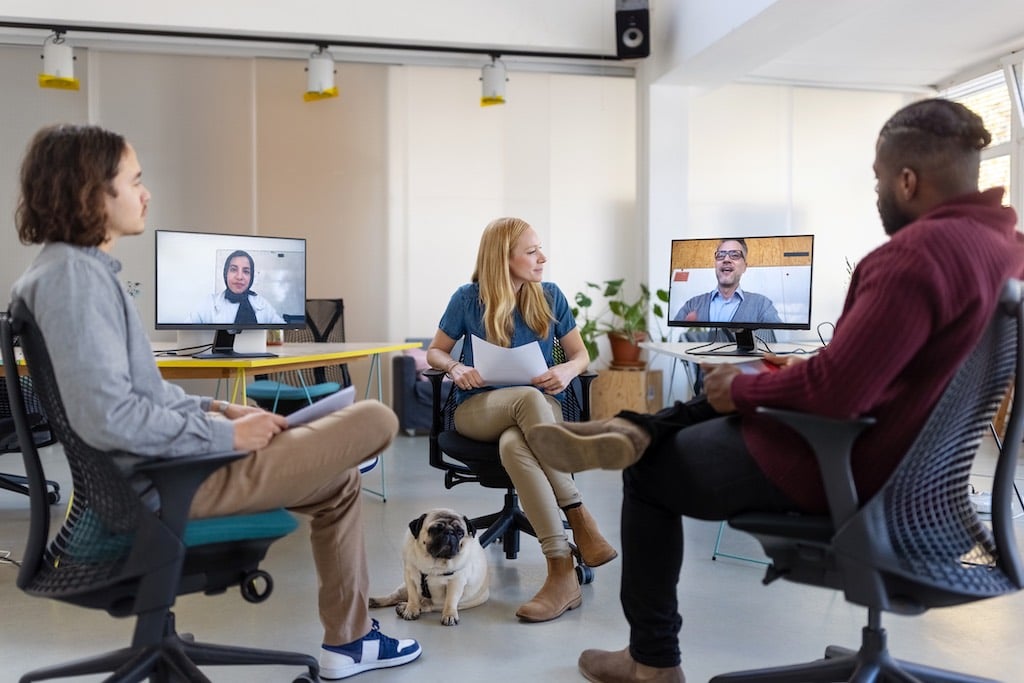What are the benefits of a hybrid workforce and how can organisations adapt their ways of working to accommodate long term?
How today’s hybrid way of working has changed the goalposts

How today’s hybrid way of working has changed the goalposts
What are the benefits of a hybrid workforce and how can organisations adapt their ways of working to accommodate long term?

Meet the author
Today’s hybrid way of working opens a diverse pool of talent that hasn’t traditionally been available to businesses with office-based workforces. People with disabilities, those from different cultures and countries, and individuals who prefer to work outside of normal office hours are now applying for, and being offered jobs that wouldn’t have been open to them previously.
As a result, companies benefiting from a diversified workforce must adapt their hybrid working strategies to ensure conditions work for the company and the individuals.
Let’s create, for the purpose of this article, a fictional Manchester-based digital marketing company. It currently has a small, local workforce that has worked tirelessly through the pandemic. Some people are now hybrid workers, but the majority are office-based. Thanks to a swelling pipeline, leaders need to take on new staff.
Meet Jane, a wheelchair user based in London who works part-time from home. The digital marketing agency based in Manchester looks like a good fit but she is unable to travel to the office. The new work-from-home policy is enticing and she aces the interview.
Meanwhile, in India, IT developer Amir sees the Manchester company’s job advert. His location is 5.5 hours ahead of the UK, which on the face of it may not be helpful, but the digital marketing company is currently in talks with an Indian tech company. Amir, who works the same hours as the prospect and is knowledgeable about the culture, would be a great addition to the workforce.
And finally, mum-of-two Olivia, a talented marketeer, is returning to the workforce after a few years as a full-time homemaker and needs some flexibility in her working hours to allow for the school run and holidays.
Jane, Amir, and Olivia are the best candidates for the vacancies. So, how can our expanding Manchester-based company make this situation work for these three people and the business? This will come down to three factors: how well the company positions its strategy, vision, and values; having the right tools and enablers in place; and building a positive culture.
Strategy, vision and values
Strategy is at the centre of everything – it enables a hybrid workforce. For the strategy to be successful, the business will need to identify its core vision and values. It is important everyone in the business, from the CEO to the new recruits, truly live and breathe the business’s values – they’re not something any business can be hybrid about. All key decisions moving forward should relate back to the strategy.
Tools
Tools are the things that allow you to work collaboratively as a hybrid workforce. With the help of translation software, the right desk and equipment for Jane to work well from home, together with collaboration and asynchronous working to account for Amir’s different time zone and Olivia’s hours, the company can forge a way ahead with its hybrid workforce.
Enablers
Enablers are the policies you might need to put in place, such as HR policies with flexible benefits. This means there is no longer a single policy that dictates people need to be in the office from 9-5. The new bespoke policies allow different people to have diverse packages because they will be in different spaces and have different needs. Jane isn’t necessarily going to need the same childcare package as a parent who works from the office.
Culture
We’ve got everything in place and now people need to act on their words. Encourage pilots and trial and error. If you have a global culture, think about religious festivals and how you will manage a team during Ramadan, for instance.
By fostering a high-performing team through a positive culture, we can create a great team that is connected and working collaboratively.
Conclusion
Organisations that want to benefit from having a bigger talent pool need to think ahead.
A one-size-fits-all approach to strategy will soon start to creak at the seams in a hybrid organisation and this will show up in the form of staff churn, increased absence, and a general workforce malaise.
To find out how we can help with your hybrid working and employee experience strategy, please get in touch.
Want more?
LISTEN: How to develop and maintain high-performing teams – PODCAST

